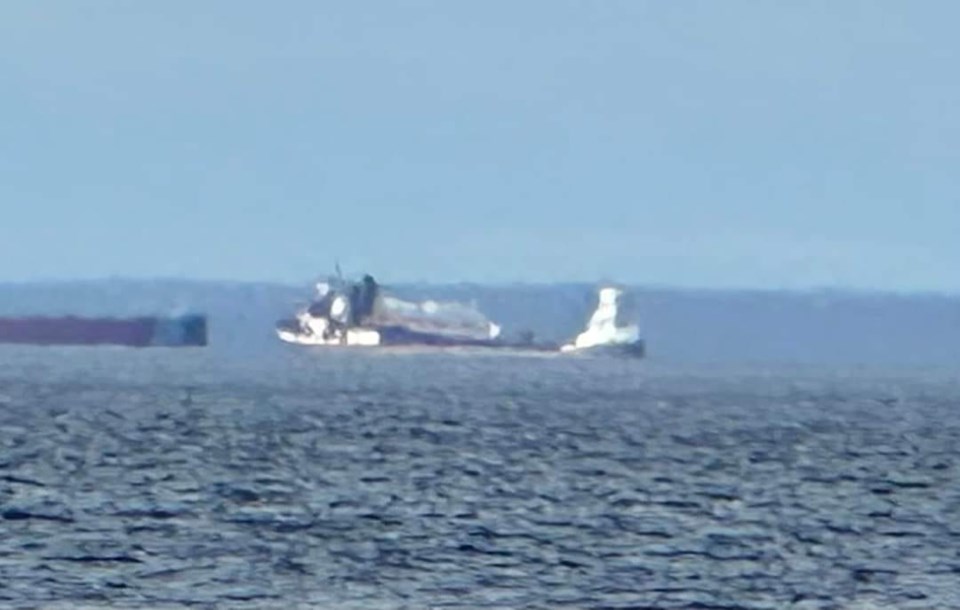(Video submitted by Imagine Films)
THUNDER BAY – The Coast Guard Sector Northern Great Lakes in Sault Ste. Marie, Michigan was notified by VHF radio that Michipicoten was taking on water at 6:46 a.m. on Saturday.
According to Lieutenant Joseph Snyder with the United States Coast Guard Sector Northern Great Lakes, who did an interview on Sunday, the crew requested Coast Guard assistance.
The Coast Guard immediately launched a boat out of its station in Bayfield, Wisconsin, as well as a helicopter from air station, Traverse City to get on scene, he said.
“Our command centre was talking constantly with the Canadian Search and Rescue Coordination centre out of Sarnia.
“Fortunately, there was no pollution in this case, but we always want to be prepared for the worst-case outcome.
“We have an agreement with the Canadian government about how we will collaborate, who the points of contact are and the best way to communicate with the Canadians.
“Those are existing plans and agreements you hope you never have to use. However we were glad they existed on a day like Saturday,” he said.
Snyder said the way they address these situations is a tiered list of priorities.
“Our first priority is always going to be safety of life at sea, that search and rescue element ensuring that the crew is safe and should the worst happen - we are well positioned to be able to affect the rescue.”
They had another 225 foot boat staged out of Duluth to launch, if necessary, if they were in a “mass rescue situation,” he said.
Once they had determined the vessel was no longer taking on water and were not at risk of sinking, they moved on to the next priority, which is always pollution, he said.
“In order to address that we engage a scientific support team with the National Oceanic Atmospheric Administration, as well as preparing for the possibility to activate our area contingency plan.
"It is a contingency plan across the Lake Superior area that has specific details about how you would handle a large-scale pollution incident, the primary contacts and who needs to be involved.”
Snyder said they are starting to look through and always hoping for the best but planning for the worst.
The final tier is going to be the marine transportation system, he said.
“A lot of commerce flows through Lake Superior and through Thunder Bay especially.
“We’re thinking ahead to what we need to do to quickly investigate, determine the cause, make sure other ships aren’t at risk, and then we make sure the marine transportation system remains fully operational,” Snyder said.
The last official update was that the Michipicoten was in Thunder Bay. Last night a diver did a preliminary damage assessment on the vessel, he said.
“It’s going to be very collaborative with their Canadian partner since it is a Canadian flag vessel, but the incident occurred in the United States waters.
“Coast Guards and the Canadians are going to have a vested interest in determining exactly what the cause of the incident was,” Snyder said.
Eleven crew members were removed off the vessel, as they were able to make an assessment and determine they could continue with just an 11-person crew.
“You would much rather be saving 11 people from the freezing waters of Lake Superior than 22 people, thinking to a worst-case scenario,” he said.
“With cases like this, Lake Superior is such a big place with a lot of players that are going to be involved in such a serious incident.
“We always like to say that when we're not operating, we're training. This is the exact kind of scenario that we never wanted to happen. But if it does, we want to make sure we've got the right people and have run through the scenarios in advance.
“It highlights how important a lot of the collaboration is up here on the Great Lakes between the United States Coast Guard, the Canadian Coast Guard, National Park Service, National Oceanic and Atmospheric Administration, and other local partners.
“I’m just really glad to see that we were able to get a positive outcome on this, no pollution, no injuries and we got everybody back home safe,” Snyder said
